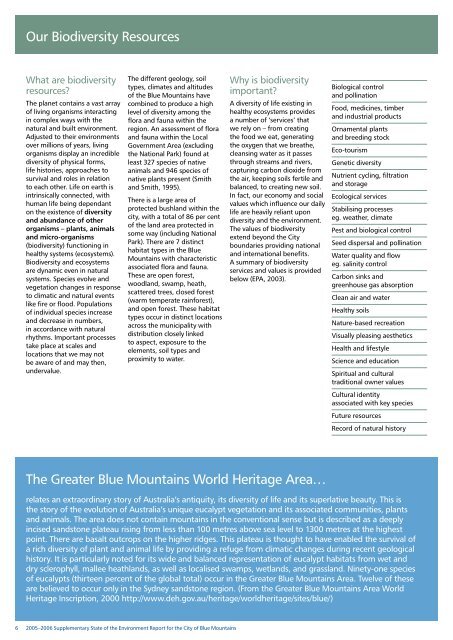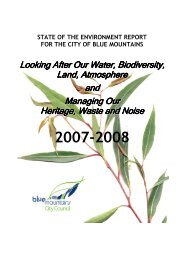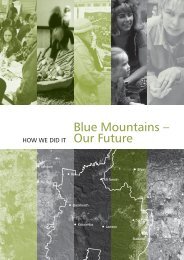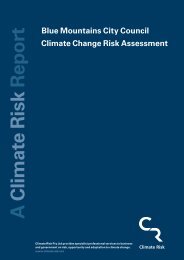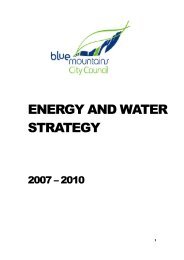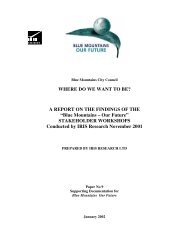State of the Environment Report for the City of Blue Mountains
State of the Environment Report for the City of Blue Mountains
State of the Environment Report for the City of Blue Mountains
You also want an ePaper? Increase the reach of your titles
YUMPU automatically turns print PDFs into web optimized ePapers that Google loves.
Our Biodiversity Resources<br />
What are biodiversity<br />
resources<br />
The planet contains a vast array<br />
<strong>of</strong> living organisms interacting<br />
in complex ways with <strong>the</strong><br />
natural and built environment.<br />
Adjusted to <strong>the</strong>ir environments<br />
over millions <strong>of</strong> years, living<br />
organisms display an incredible<br />
diversity <strong>of</strong> physical <strong>for</strong>ms,<br />
life histories, approaches to<br />
survival and roles in relation<br />
to each o<strong>the</strong>r. Life on earth is<br />
intrinsically connected, with<br />
human life being dependant<br />
on <strong>the</strong> existence <strong>of</strong> diversity<br />
and abundance <strong>of</strong> o<strong>the</strong>r<br />
organisms – plants, animals<br />
and micro-organisms<br />
(biodiversity) functioning in<br />
healthy systems (ecosystems).<br />
Biodiversity and ecosystems<br />
are dynamic even in natural<br />
systems. Species evolve and<br />
vegetation changes in response<br />
to climatic and natural events<br />
like fire or flood. Populations<br />
<strong>of</strong> individual species increase<br />
and decrease in numbers,<br />
in accordance with natural<br />
rhythms. Important processes<br />
take place at scales and<br />
locations that we may not<br />
be aware <strong>of</strong> and may <strong>the</strong>n,<br />
undervalue.<br />
The different geology, soil<br />
types, climates and altitudes<br />
<strong>of</strong> <strong>the</strong> <strong>Blue</strong> <strong>Mountains</strong> have<br />
combined to produce a high<br />
level <strong>of</strong> diversity among <strong>the</strong><br />
flora and fauna within <strong>the</strong><br />
region. An assessment <strong>of</strong> flora<br />
and fauna within <strong>the</strong> Local<br />
Government Area (excluding<br />
<strong>the</strong> National Park) found at<br />
least 327 species <strong>of</strong> native<br />
animals and 946 species <strong>of</strong><br />
native plants present (Smith<br />
and Smith, 1995).<br />
There is a large area <strong>of</strong><br />
protected bushland within <strong>the</strong><br />
city, with a total <strong>of</strong> 86 per cent<br />
<strong>of</strong> <strong>the</strong> land area protected in<br />
some way (including National<br />
Park). There are 7 distinct<br />
habitat types in <strong>the</strong> <strong>Blue</strong><br />
<strong>Mountains</strong> with characteristic<br />
associated flora and fauna.<br />
These are open <strong>for</strong>est,<br />
woodland, swamp, heath,<br />
scattered trees, closed <strong>for</strong>est<br />
(warm temperate rain<strong>for</strong>est),<br />
and open <strong>for</strong>est. These habitat<br />
types occur in distinct locations<br />
across <strong>the</strong> municipality with<br />
distribution closely linked<br />
to aspect, exposure to <strong>the</strong><br />
elements, soil types and<br />
proximity to water.<br />
Why is biodiversity<br />
important<br />
A diversity <strong>of</strong> life existing in<br />
healthy ecosystems provides<br />
a number <strong>of</strong> ‘services’ that<br />
we rely on – from creating<br />
<strong>the</strong> food we eat, generating<br />
<strong>the</strong> oxygen that we brea<strong>the</strong>,<br />
cleansing water as it passes<br />
through streams and rivers,<br />
capturing carbon dioxide from<br />
<strong>the</strong> air, keeping soils fertile and<br />
balanced, to creating new soil.<br />
In fact, our economy and social<br />
values which influence our daily<br />
life are heavily reliant upon<br />
diversity and <strong>the</strong> environment.<br />
The values <strong>of</strong> biodiversity<br />
extend beyond <strong>the</strong> <strong>City</strong><br />
boundaries providing national<br />
and international benefits.<br />
A summary <strong>of</strong> biodiversity<br />
services and values is provided<br />
below (EPA, 2003).<br />
Biological control<br />
and pollination<br />
Food, medicines, timber<br />
and industrial products<br />
Ornamental plants<br />
and breeding stock<br />
Eco-tourism<br />
Genetic diversity<br />
Nutrient cycling, filtration<br />
and storage<br />
Ecological services<br />
Stabilising processes<br />
eg. wea<strong>the</strong>r, climate<br />
Pest and biological control<br />
Seed dispersal and pollination<br />
Water quality and flow<br />
eg. salinity control<br />
Carbon sinks and<br />
greenhouse gas absorption<br />
Clean air and water<br />
Healthy soils<br />
Nature-based recreation<br />
Visually pleasing aes<strong>the</strong>tics<br />
Health and lifestyle<br />
Science and education<br />
Spiritual and cultural<br />
traditional owner values<br />
Cultural identity<br />
associated with key species<br />
Future resources<br />
Record <strong>of</strong> natural history<br />
The Greater <strong>Blue</strong> <strong>Mountains</strong> World Heritage Area…<br />
relates an extraordinary story <strong>of</strong> Australia’s antiquity, its diversity <strong>of</strong> life and its superlative beauty. This is<br />
<strong>the</strong> story <strong>of</strong> <strong>the</strong> evolution <strong>of</strong> Australia’s unique eucalypt vegetation and its associated communities, plants<br />
and animals. The area does not contain mountains in <strong>the</strong> conventional sense but is described as a deeply<br />
incised sandstone plateau rising from less than 100 metres above sea level to 1300 metres at <strong>the</strong> highest<br />
point. There are basalt outcrops on <strong>the</strong> higher ridges. This plateau is thought to have enabled <strong>the</strong> survival <strong>of</strong><br />
a rich diversity <strong>of</strong> plant and animal life by providing a refuge from climatic changes during recent geological<br />
history. It is particularly noted <strong>for</strong> its wide and balanced representation <strong>of</strong> eucalypt habitats from wet and<br />
dry sclerophyll, mallee heathlands, as well as localised swamps, wetlands, and grassland. Ninety-one species<br />
<strong>of</strong> eucalypts (thirteen percent <strong>of</strong> <strong>the</strong> global total) occur in <strong>the</strong> Greater <strong>Blue</strong> <strong>Mountains</strong> Area. Twelve <strong>of</strong> <strong>the</strong>se<br />
are believed to occur only in <strong>the</strong> Sydney sandstone region. (From <strong>the</strong> Greater <strong>Blue</strong> <strong>Mountains</strong> Area World<br />
Heritage Inscription, 2000 http://www.deh.gov.au/heritage/worldheritage/sites/blue/)<br />
<br />
2005–2006 Supplementary <strong>State</strong> <strong>of</strong> <strong>the</strong> <strong>Environment</strong> <strong>Report</strong> <strong>for</strong> <strong>the</strong> <strong>City</strong> <strong>of</strong> <strong>Blue</strong> <strong>Mountains</strong>


